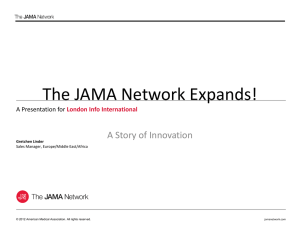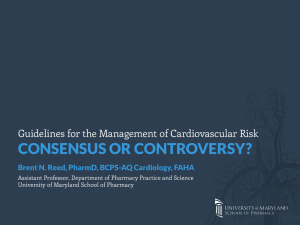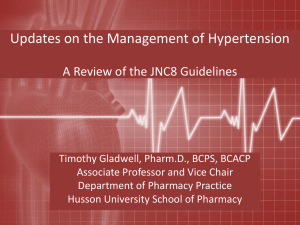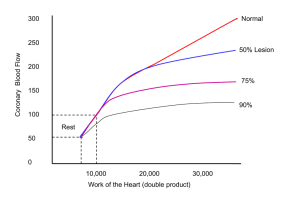High Blood Pressure in Adults – JNC 8 Review
advertisement
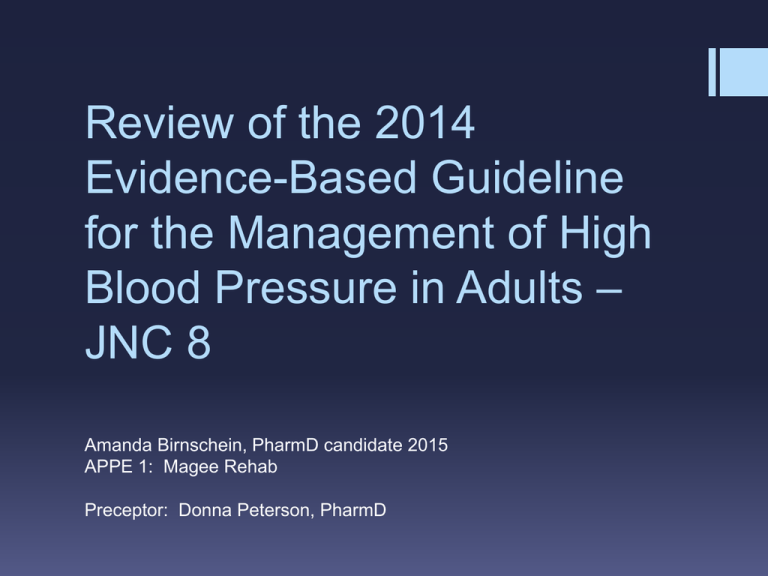
Review of the 2014 Evidence-Based Guideline for the Management of High Blood Pressure in Adults – JNC 8 Amanda Birnschein, PharmD candidate 2015 APPE 1: Magee Rehab Preceptor: Donna Peterson, PharmD In the Past……JNC 7 Treatment Goals: • <140/80 for all patients without compelling indications • <130/80 for patients with diabetes and CKD Hobanian AV, Bakris GL, Black HR, et al. JAMA. 2003;289(19):2560-2572. JNC 7 – Compelling Indications Hobanian AV, Bakris GL, Black HR, et al. JAMA. 2003;289(19):2560-2572. 2014 Guidelines – JNC 8 Answered 3 main Questions about adults with hypertension: 1. Does initiating antihypertensive pharmacologic therapy at specific blood pressure thresholds improve health outcomes? 2. Does treatment with anithypertensive pharmacologic therapy to a specified blood pressure goal lead to improvements in health outcomes? 3. Do various antihypertensive drugs or drug classes differ in comparative benefits and harms on specific health outcomes? James PA, Oparil S, Carter BL, et al. JAMA. 2013;doi:10.1001/jama:284-427. 2014 Guidelines – JNC 8 Based on 9 recommendations: Recommendations 1 – 5 address thresholds and goals for blood pressure treatment Recommendations 6 – 8 address selection of antihypertensive drugs Recommendation 9 is a summary of strategies based on expert opinion for starting and adding antihypertensive drugs James PA, Oparil S, Carter BL, et al. JAMA. 2013;doi:10.1001/jama:284-427. Recommendation 1 – Threshold and Goals General population > 60 years old: Initiate pharmacologic treatment of SBP > 150 mm Hg or DBP > 90 mm Hg Reduces stroke, heart failure, and coronary heart disease (CHG) Setting a goal <140 mm Hg provides no additional benefit Though, if treatment was <140 mm Hg and not associated with adverse effects no adjustments made (corollary recommendation) High-risk groups (black persons, CVD including stroke, and multiple risk factors) insufficient evidence to raise the SBP target from <140 mm Hg to <150 mm Hg More research needed to identify optimal goals of SBP James PA, Oparil S, Carter BL, et al. JAMA. 2013;doi:10.1001/jama:284-427. Recommendation 2 – Threshold and Goals General population < 60 years old: Initiate pharmacologic treatment for DBP > 90 mm Hg For ages 30 – 59 years Strong recommendation from 5 trials Decreasing DBP to < 90 mm Hg reduces cerebrovascular events, heart failure, and overall mortality For ages 18 – 29 years Expert Opinion, no good- or fair-quality RCTs James PA, Oparil S, Carter BL, et al. JAMA. 2013;doi:10.1001/jama:284-427. Recommendation 3 – Threshold and Goals General population < 60 years old Initiate pharmacologic treatment for SBP > 140 mm Hg Absence of RCTs that compared the current SBP standard of 140 mm Hg with another higher or lower standard in age group – no compelling reason to change Many trials for DBP also achieved a SBP lower than 140 mm Hg Similar recommendation for CKD and diabetic patients James PA, Oparil S, Carter BL, et al. JAMA. 2013;doi:10.1001/jama:284-427. Recommendation 4 – Threshold and Goals Patients > 18 years old with CKD: Initiate pharmacologic treatment for SBP > 140 or DPB > 90 mm Hg CKD as defined by GFR < 60 mL/min/1.73 m2 in patients up to age 70 years old OR Albuminuria as defined as > 30 mg/g of creatinine at any GFR at any age Need to weigh the benefits vs risks for individuals > 70 years old and a GFR < 60 mL/min/1.73 m2 Consider factors such as frailty, comorbidities, and albuminuria James PA, Oparil S, Carter BL, et al. JAMA. 2013;doi:10.1001/jama:284-427. Recommendation 5 – Threshold and Goals Patients > 18 years old with diabetes Initiate pharmacologic treatment for SBP > 140 mm Hg or DBP > 90 mm Hg Moderate-quality evidence that treatment to an SBP < 150 mm Hg improves cardiovascular and cerebrovascular health outcomes and lowers mortality < 140 based on expert opinion from ACCORD-BP trial Goal not supported of SBP < 130 mm Hg or DBP < 80 mm Hg James PA, Oparil S, Carter BL, et al. JAMA. 2013;doi:10.1001/jama:284-427. Recommendation 6 - Treatment Nonblack population with diabetes – initial antihypertensive treatment should include 1 of the following: Thiazide-type diuretic (hydrochlorothiazide, chlorthalidone, and indapamide) Calcium channel blocker (CCB) Angiotensin-converting enzyme inhibitor (ACEI) Angiotensin receptor blocker (ARB) Each of the 4 drug classes yielded comparable effects on overall mortality and cardiovascular, cerebrovascular, and kidney outcomes One exception: heart failure In order of efficacy (top to bottom): Thiazide-type ACEI CCB Patients needing more than 1 agent: Any of the 4 classes would be good choices as add-on agents James PA, Oparil S, Carter BL, et al. JAMA. 2013;doi:10.1001/jama:284-427. Recommendation 7 - Treatment Black population with diabetes – initial antihypertensive treatment should include 1 of the following: Thiazide-type diuretic CCB Thiazide-type diuretic more effective in improving cerebrovascular, heart failure, and combined cardiovascular outcomes compared to an ACEI No difference in outcomes between CCB and diuretic CCB over ACEI 51% higher rate of stroke in black patients with the use of an ACEI as initial therapy compared with a CCB ACEI less effective in BP reduction Consider using ACEI/ARB on an individual basis, especially for proteinuria James PA, Oparil S, Carter BL, et al. JAMA. 2013;doi:10.1001/jama:284-427. Recommendation 8 - Treatment Patients > 18 years old with CKD – initial or add-on antihypertensive treatment should include 1 of the following: ACEI or ARB Improve kidney outcomes Applies to all CKD patients with hypertension, regardless of race or diabetes status No evidence in patients > 75 years old Can consider thiazide-type diuretic or CCB Neither ACEIs nor ARBs improve cardiovascular outcomes compared with a CCB or Beta-blocker James PA, Oparil S, Carter BL, et al. JAMA. 2013;doi:10.1001/jama:284-427. Recommendation 9 - Summary Goal BP not reached within 1 month of treatment Increase dose of initial drug OR Add a second drug from one of the 4 recommended classes (thiazide-type diuretic, CCB, ACEI, or ARB) Do not use an ACEI and an ARB together in the same patient Continue to assess BP and adjust the regimen until goal BP is reached If not reached with 2 drugs, add and titrate a third drug If goal BP cannot be reached using the recommended classes because of contraindications or the need to use more than 3 drugs to reach goal Use antihypertensives in other classes James PA, Oparil S, Carter BL, et al. JAMA. 2013;doi:10.1001/jama:284-427. Strategies to Dose Antihypertensive Drugs Strategy Description A Start one drug, titrate to maximum dose, and then add a second drug B Start one drug and then add a second drug before achieving maximum dose of the initial drug C Begin with 2 drugs at the same time, either as 2 separate pills as a single pill combination James PA, Oparil S, Carter BL, et al. JAMA. 2013;doi:10.1001/jama:284-427. Recommendation Summary Patients > 60 years old, initiate pharmacologic treatment to lower SBP > 150 mm Hg or DBP > 90 mm Hg Treat to a goal < 150/90 mm Hg Patients < 60 years old, initiate pharmacologic treatment to lower SBP > 140 mm Hg or DPB > 90 mm Hg Treat to a goal < 140/90 mm Hg Patients > 18 years old with diabetes or CKD initiate pharmacologic treatment to lower SBP > 140 or DBP > 90 Treat to a goal < 140/90 James PA, Oparil S, Carter BL, et al. JAMA. 2013;doi:10.1001/jama:284-427. Hypertension Guidelines Table Thomas G, Shishehbor MH, Brill D, et al. Cleveland Clinic Journal of Medicine. 2014;81(3):178-188. Lifestyle Modification Diet Dietary Approaches to Stop Hypertension (DASH) diet and reduction of sodium intake (< 2,400 mg/day) Greater blood-pressure-lowering effect when the both are combined Physical activity Moderate to vigorous physical activity for 160 minutes/week 4 sessions/week, ~40 minutes in length Weight loss No review of blood-pressure-lowering effect of weight loss Maintain a healthy weight in controlling blood pressure Alcohol intake No specific recommendation Thomas G, Shishehbor MH, Brill D, et al. Cleveland Clinic Journal of Medicine. 2014;81(3):178-188. Strengths and Limitations of JNC 8 Strengths Simplified algorithm of when to treat and treatment goals Only RCT data was included Utilized information with different age groups Relaxed blood pressure goals in elderly patients Based recommendations on clinically significant endpoints instead of surrogate markers for blood pressure Limitations Treatment adherence and medication costs were thought to be beyond the scope of review Only RCT data was included The review was not designed to determine risk-benefit of therapy-associated adverse effects and harms Blood pressure targets in some subgroups not clearly addressed History of stroke James PA, Oparil S, Carter BL, et al. JAMA. 2013;doi:10.1001/jama:284-427. Thomas G, Shishehbor MH, Brill D, et al. Cleveland Clinic Journal of Medicine. 2014;81(3):178-188. What are the differences from JNC 7? Focused on evidenced based recommendation Higher target SBP for patients > 60 years old Limited data support either SBP 150 mm Hg or 140 mm Hg Removed special lower target BP for those with CKD or diabetes Liberalized initial drug treatment choices Thiazide-type diuretics no longer recommended as the only first line therapy ACEI/ARBs do not have cardiovascular benefits Thomas G, Shishehbor MH, Brill D, et al. Cleveland Clinic Journal of Medicine. 2014;81(3):178-188. Using the Guidelines – Patient Case #1 AC is a 64 year old female with a PMH of HTN, DM, and hyperlipidemia Medications: amlodipine 10 mg PO daily, atorvastatin 20 mg PO daily, lisinopril 10 mg PO daily (same medications for last 3 months) BP on exam: 136/82 Repeat – 138/82 According to JNC 7, what would you do in terms of AC’s antihypertensive therapy? According to JNC 8, what would you do in terms of AC’s antihypertensive therapy? Using the Guidelines – Patient Case #2 LZ is an 82 year old man with a PMH of GERD, HTN, and COPD Current medications: hydrochlorothiazide 25 mg PO daily, pantoprazole 40 mg po daily, Advair 250/50 PO BID, Spiriva 18 mcg PO daily, and albuterol inhaler PO Q4H PRN SOB BP on exam: 148/86 Repeat-148/84 According to JNC 7, what would you do in terms LZ’s antihypertensive therapy? According to JNC 8, what would you do in terms of HN’s antihypertensive therapy? Therapy Overview Patient Population General nonblack population, including comorbid conditions Initial Drug Therapy • Thiazide-type diuretic • ACEI/ARB • CCB Hypertension with CKD, regardless of • ACEI race or diabetes status • ARB Black patients with HTN + Diabetes • Thiazide-type diuretic • CCB Black patients with comorbid CKD With proteinuria: • ACEI or ARB Without proteinuria: • Thiazide-type diuretic • ACEI/ARB • CCB ***Use ACEI or ARB as add-on agent if not already present as initial therapy*** Wojtaszek D, Dang DK. Drug Topics. 2014;158(5):33-42. Antihypertensive Medications ACEI • Captopril • Enalapril • Lisinopril ARB • Losartan • Valsartan • Irbesartan CCB • Amlodipine • Diltiazem ER Thiazide-type diuretics • Chlorthalidone • Hydrochlorothiazide • Indapamide Beta-Blockers • Atenolol • Metoprolol Initial Daily Dose (mg) 50 5 10 50 40-80 75 Target Dose in RCTs Reviewed (mg) 150-200 20 40 5100 160-320 300 2.5 120-180 12.5 12.5-25 1.25 25-50 50 10 360 12.5-25 25-100 1.25-2.5 100 100-200 Wojtaszek D, Dang DK. Drug Topics. 2014;158(5):33-42. Number of doses/da y 2 1-2 1 1-2 1 1 1 1 1 1-2 1 1 1-2 Common and/or Major Adverse Effects Hyperkalmia, angioedema, acute kidney failure, SCr, dry cough Hyperkalmia, angioedema, acute kidney failure, SCr • Dihydropyridines Reflex tachy, peripheral edema, dizziness, HA, flushing, cardiac contractility • Nondihydropyridines Bradycardia, heart block, cardiac contractility, constipation, gingival hyperplasia Electrolyte abnormalities, hyperuricemia, hyperglycemia, hypercalcemia, hyperlipidemia Bradycardia, heart block, rebound HTN, masking hypoglycemia, transient chol, bronchospasm In Conclusion Guidelines are not rules Only provide framework Formulate antihypertensive plan on the basis of individual patient characteristics Co-morbidities Lifestyle factors Medication side effects Patient preferences Cost issues Adherence Thomas G, Shishehbor MH, Brill D, et al. Cleveland Clinic Journal of Medicine. 2014;81(3):178-188. References 1. Hobanian AV, Bakris GL, Black HR, et al. The seventh report of the Joint National Committee on Prevention, Detection, Evaluation, and Treatment of High Blood Pressure: the JNC 7 report. JAMA. 2003;289(19):25602572. 2. James PA, Oparil S, Carter BL, et al. 2014 Evidencedbased guideline for the management of high blood pressure in adults: report from the panel members appointed to the Eighth Joint National Committee (JNC 8). JAMA. 2013;doi:10.1001/jama:284-427. 3. Thomas G, Shishehbor MH, Brill D, et al. New hypertension guidelines: one size fits most? Cleveland Clinic Journal of Medicine. 2014;81(3):178-188. 4. Wojtaszek D, Dang DK. MTM essentials for hypertension management, Part 2: drug therapy considerations. Drug Topics. 2014;158(5):33-42.

